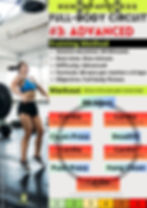Full Body Circuit Workout
- Hungry4Fitness
- Jun 21, 2023
- 5 min read

This full body circuit workout targets all of the major muscle groups. In addition, it also engages the heart, lungs, and vascular system.
But there are many more benefits on offer besides those briefly outlined above. As Royal Marine PTI Sean Lerwill points out, ‘For general, non-specific fitness, circuit training is probably the best one-off method available to develop endurance, stamina and strength.’
The full body circuit workout below is no exception. If you can incorporate the circuit into your weekly routine, you’re guaranteed to train every aspect of your fitness.
For a fuller outline of the health and fitness benefits of the workout, read on. Alternatively, just start the circuit!
Full body circuit workout benefits
The chief benefit of this circuit is that it stimulates your full body. But you’d be right in asking, what does that even mean? It’s hard to find an agreed-upon definition of the key characteristics of a full body workout.
However, common consensus suggests that for a workout to be billed as ‘full body’ it must activate all the major muscle groups, all the major body systems, and two or more components of fitness. In short, a full body workout must do exactly that – train the full body.
Full body circuit vs. conventional resistance training
We’ll more easily understand the distinction if we compare a full body workout with one that is not as broad in scope. Consider a conventional gym-based resistance routine that specifically targets a single muscle or small cluster of muscles: the classic biceps and triceps workout.
First, such a workout engages only a fraction of your physicality: the muscle of your arms. Also, the exercises employed to achieve this very narrow aim are often isolation movements – biceps curls, triceps extension, and the like. While isolation exercises serve a purpose, they are vastly inferior to functional compound lifts.
Arnold Schwarzenegger tells us that, for building strength, size and a robust body we must prioritise compound exercises over isolation movements (The Encyclopaedia Of Modern Bodybuilding).
Second, conventional resistance routines rarely engage more than one component of fitness. For example, a chest and back workout is almost exclusively weighted toward strength development. This is a massively limiting training approach when we reflect on the fact that there are more than eight recognised components of fitness.
The final limitation of a conventional resistance routine that I’ll mention is that they are not effective at promoting health. Here’s what I mean. Training your biceps and triceps may build a pair of Popeye pipes that look good under a tight tee. This comes at a cost. Such forms of training do not develop functional strength – the stuff that makes everyday tasks easier.
Furthermore, they do not improve the strength and efficiency of your cardio-respiratory system. Also, as Daniel Liberman argues in his brilliant book Exercised: The Science of Physical Activity, Rest & Health, weight training is woeful at facilitating weight loss.
Why do a full body circuit workout
Now let’s quickly contrast a conventional resistance workout with the full body circuit. The training inclusivity of circuits means that you could set aside stations that target specific muscles – such as your biceps and triceps.
In addition, functional movements and aerobic exercises could be enlisted to broaden the benefits. Doing so would enable you to sculpt lean muscle while improving functional fitness, enhancing heart and lung efficiency, burning fat, and forging a more diverse physicality. I’ve summarised our comparison in the following table:

Full body circuit workout
Before starting the circuit ensure to complete a 10-minute whole-body warm-up. The warm-up should include a mix of cardiovascular exercises and resistance movements that feature throughout the workout. To keep life simple, spend 5 to 7 minutes doing CV before progressing through one or two low-intensity laps of the circuit.
For this full body workout, I’ve used the circular circuit design. As well as being the easiest to follow (and explain), circular circuits are super-customisable. If you happen upon an exercise in the workout that you can’t do, you can replace it without impacting the training dynamic.
For those that are unfamiliar with the circular design, I’ve outlined the mechanics. If you’re unfamiliar with the circular circuit design, here’s how they work.
Circular circuit
In the plan below you’ll see a series of exercise stations organised into a loop. Beginning at the first station, you will exercise for the stipulated duration then move on to the next station in line. You’ll take a short recovery break once you’ve completed one lap of the circuit. This process is repeated until you have completed the specified number of laps.
To appeal to a wider audience, I’ve created three separate circuits each pitched at a different level. The first circuit has been crafted for the beginner. This pared-down circuit is comprised of bodyweight and cardio exercises. The second circuit, for intermediates, features more stations and a mixture of bodyweight and resistance exercises. And the final circuit is, of course, the most challenging of the three. It’s comprised of a series of complex compound exercises which are interspersed with short cardio bursts.
Full body circuit key points
If you’ve not got a warm-up of your own, here’s one you can follow: 1 min mobility exercises → 3 minutes cardio (rowing, skipping, the cross-trainer) → one low-intensity lap of the circuit (20 seconds each station) → 2 minutes cardio (rowing, skipping, the cross-trainer) → one low-intensity lap of the circuit (20 seconds each station) → Start the circuit!
Organise your circuit before setting off.
You will be spending one minute at each station. To improve transition efficiency, use a countdown timer set with audible notifications to sound every 60 seconds.
Using the session plan, progress around the circuit. Aim to complete one full lap before resting. Try to take no more than one minute's rest. However, if you feel that you need longer, do so.
Complete the stipulated number of laps before initiating the cool-down and stretch. (Use this 10-minute stretching plan to reduce the severity of the dreaded DOMS!)



Full body circuit workout hints and tips
Beginners can set themselves the training aim of progressing through all three circuits. Not all in one go though! Complete the first circuit once or twice a week for a month. After this time, advance to the intermediate session plan and apply the same method. Follow this formula until you have completed all three circuits.
Remember, the exercise stations are not etched in stone. That is, you should change an exercise if you do not feel completely confident in performing it. Also, if the organisation of the circuits does not align with your training objective modify them to suit. For example, if you want to focus more on strength and muscular endurance, you could replace some of the cardio stations with resistance exercises.
To the practitioners of the sport, consider integrating exercises, activities, and drills relevant to your sport. A boxer, by way of example, could shadowbox instead of doing cardio. Moreover, resistance exercises could be replaced with heavy bag training (or sparring). These same ideas could be applied to any sport.
Related: Best Boxing Reflex Bags for the home gym
Enjoyed these circuits?
Then get your hands on over 80 more with the Hungry4Fitness Book of Circuits & Workouts Volume 3.

*
_p.png)
